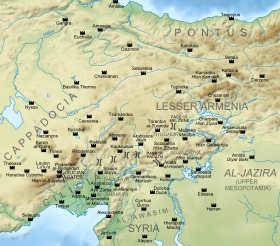Al-Awasim
al-ʿāṣimah, اَلْـعَـاصِـمَـة, "protectress") was the Arabic term used to refer to the Muslim side of the frontier zone between the Byzantine Empire and the Umayyad and Abbasid Caliphates in Cilicia, northern Syria and Upper Mesopotamia.[2][8][9] This process was marked by a gradual consolidation of the previously deserted zone and its transformation into a settled and fortified borderland, especially after the Byzantines abandoned Cilicia during the reign of Caliph Abd al-Malik ibn Marwan (r. 685–705).Chalkis), until Harun al-Rashid established a separate jund al-ʿAwāṣim (جُـنْـد الْـعَـوَاصِـم) in 786, covering the entire region from the Byzantine border in the north and west to the Euphrates in the east and a line running south of Antioch (Ar.[2][13][14] The al-ʿAwāṣim proper served as the second defensive line behind the Thughūr, stretching across northern Syria and comprising the towns of Baghras, Bayās, Dulūk (Gr.[17] "...from all the great towns within the borders of Persia and Mesopotamia, and Arabia, Syria, Egypt, and Morocco, there is no city but has in Tarsus a hostelry for its townsmen, where the warriors for the Faith from each particular country live.And, when they have once reached Tarsus, they settle there and remain to serve in the garrison; among them prayer and worship are most diligently performed; from all hands, funds are sent to them, and they receive alms rich and plentiful; also there is hardly a sultan who does not send hither some auxiliary troops."The caliphs repopulated the area by bringing in colonists and regular soldiers from Syria but also Persians, Slavs, Arab Christians, and people from the eastern edges of the Muslim world: settlers from Khurasan, the Sayābija tribe or Jatts (Ar.Under Harun al-Rashid, taxation from the Cilician sector brought in 100,000 gold dinars every year, which were all spent locally for public works, salaries, espionage etc.[25] By the 9th century, the Arab raiding expeditions launched against Byzantium from the frontier zone had gradually assumed an almost ritual character and were strictly organized.There is nevertheless evidence of some prosperity, based on agriculture and commerce, especially during the second half of the 9th century, when the borderlands became a node in a commercial route linking Basra with northern Syria and even Constantinople.[21][29] After 842 and for most of the later 9th century, the decline of Abbasid power meant that control over the Thughūr gradually devolved to semi-independent border emirates, chiefly Tarsus, Malatya and Qālīqalā, which were left largely to fend on their own against a resurgent Byzantium.[30][31][32] With the onset of the Abbasid Caliphate's terminal period of crisis after 928, control of the Muslim frontier cities shifted to the Ikhshidid and Hamdanid dynasties.
Upper MarchCentral MarchLower MarchCiliciaUpper MesopotamiaAbbasid CaliphateIkhshididsHamdanidsMamluks of EgyptMamluk Sultanate of EgyptArabicByzantine EmpireUmayyadAbbasidCaliphatesMuslim conquestsmarcheskleisouraiakritaial-AndalusTransoxianaMamluk SultanateSyrian regionMuslim conquest of the LevantTaurusAnti-TaurusAnatoliaHeraclius717–18 Siege of ConstantinopleAbd al-Malik ibn MarwanAbbasidsHarun al-RashidTarsusMalatyaEuphrateschoke pointsMuslim SyriaQinnasrinAntiochAleppoManbijBaghrasBayāsDulūkAlexandrettaCyrrhusRa'bānJaziranAmanusArmeniaDiyār BakrMopsuestiaAnazarbusal-HārūniyaMar'ashMuawiyah Ial-ḤadathKaisumZapetra/SozopetraSamosataḤiṣn ZiyadErzurumQudama ibn Ja'farwarriors for the FaithIbn HawqalPersiansArab ChristiansKhurasanZuṭṭʿushrkharājgold dinarsHugh N. Kennedyfiercely contestedConstantinopleemiratesBattle of LalakaonIkhshididHamdanidJohn Kourkouasemir of AleppoSayf al-DawlaNikephoros II PhokasEgyptian MamluksTurkomanOttoman EmpireRamadanidsDulkadiridSerfendikarDarendeDivriğiAhmad al-QalqashandiniyābātElbistanal-BiraQal'at Ja'baral-RuhaGhazi (warrior)RibāṭsDigenes AkritasKarbeasGibb, H. A. R.Kramers, J. H.Lévi-Provençal, E.Schacht, J.Lewis, B.Pellat, Ch.Kaegi, Walter EmilKazhdan, AlexanderThe Oxford Dictionary of ByzantiumKennedy, HughToynbee, ArnoldVasiliev, Alexander A.Henri GrégoireMarius CanardWhittow, MarkBonner, MichaelDistrictsBilad al-ShamRashidun PeriodJund HimsJund DimashqJund al-UrdunnJund FilastinUmayyad PeriodJund Qinnasrin